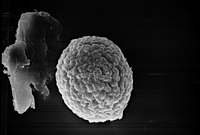Karnal bunt: Difference between revisions
First Light (talk | contribs) m Reverted edits by 78.145.44.147 (talk) to last version by Agradman |
Updated URLs of Kansas Stat University external links |
||
| Line 35: | Line 35: | ||
==External links== |
==External links== |
||
*[http://www. |
*[http://www.ksre.ksu.edu/library/crpsl2/mf2220.pdf Karnal Bunt Questions and Answers] |
||
*[http://www. |
*[http://www.ksre.ksu.edu/library/crpsl2/mf2585.pdf Karnal Bunt SOPs for Harvest Equipment] |
||
*[http://www. |
*[http://www.ksre.ksu.edu/library/crpsl2/mf2584.pdf Karnal Bunt SOPs for Seed Procurement and Planting] |
||
{{plant-disease-stub}} |
{{plant-disease-stub}} |
||
Revision as of 19:42, 2 February 2012
| Tilletia indica | |
|---|---|

| |
| Scientific classification | |
| Kingdom: | |
| Division: | |
| Subdivision: | |
| Class: | |
| Order: | |
| Family: | |
| Genus: | |
| Species: | T. indica
|
| Binomial name | |
| Tilletia indica Mitra, (1931)
| |
| Synonyms | |
|
Neovossia indica | |
Karnal bunt (also known as partial bunt) is a fungal disease of wheat, durum wheat, and triticale. The smut fungus Tilletia indica invades the kernels and obtains its nutrition from the endosperm, leaving behind waste products with a disagreeable odor that makes bunted kernels too unpalatable for use in flour.
Origin and Spread
Karnal bunt was named after Karnal, the district in the Indian state of Haryana where it was first reported in 1931. It was soon discovered in other nearby wheat-producing regions, including Iraq, Nepal, Pakistan, and Afghanistan.[1] It was introduced to Mexico in the 1960s, and it was first discovered in the United States in 1996 in Arizona. Since then, it has also been found in California, New Mexico, and Texas.[2] Quarantines, some of them controversial, were imposed there. A few of them have since been lifted, but the USDA continues to monitor the disease in the United States.
Disease Cycle
The disease is primarily spread through contaminated seed or farm equipment, although it may also be carried short distances by the wind. The fungal spores can then remain viable for several years, germinating when weather conditions become favorable for development. Once the spores germinate, they infest the wheat flowers and develop large masses of spores on the embryo end of the kernels (the entire kernel is not usually affected).[3]
Impacts
Karnal bunt has not been shown to have a significant impact on crop yield, although economic losses may occur due to quarantine and export restrictions for infected areas.[2]
Regulation
Appearance of the disease in the United States in early 1996 resulted in the Animal and Plant Health Inspection Service (APHIS) implementing an emergency quarantine, inspection, and certification program for wheat moving out of the infested areas, along with regulations on sanitizing machinery and storage facilities. Many foreign countries have a zero tolerance for karnal bunt in import shipments. [4]
References
- ^ Karnal Bunt of Wheat Technical Manual. South Africa Department of Agriculture, 2001. Retrieved on 2008-10-26.
- ^ a b Karnal Bunt: A Fungal Disease of Wheat. USDA Animal and Plant Health Inspection Service, March 2004. Retrieved on 2008-10-26.
- ^ Karnal bunt Disease. Texas Department of Agriculture. Retrieved on 2008-10-26.
- ^ CRS Report for Congress: Agriculture: A Glossary of Terms, Programs, and Laws, 2005 Edition - Order Code 97-905
